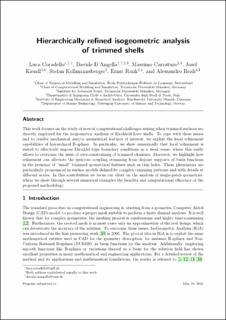| dc.contributor.author | Coradello, Luca | |
| dc.contributor.author | D’Angella, Davide | |
| dc.contributor.author | Carraturo, Massimo | |
| dc.contributor.author | Kiendl, Josef | |
| dc.contributor.author | Kollmannsberger, Stefan | |
| dc.contributor.author | Rank, Ernst | |
| dc.contributor.author | Reali, Alessandro | |
| dc.date.accessioned | 2021-10-22T06:33:41Z | |
| dc.date.available | 2021-10-22T06:33:41Z | |
| dc.date.created | 2021-02-23T17:06:19Z | |
| dc.date.issued | 2020 | |
| dc.identifier.citation | Computational Mechanics. 2020, 66 (2), 431-447. | en_US |
| dc.identifier.issn | 0178-7675 | |
| dc.identifier.uri | https://hdl.handle.net/11250/2824847 | |
| dc.description.abstract | This work focuses on the study of several computational challenges arising when trimmed surfaces are directly employed for the isogeometric analysis of Kirchhoff–Love shells. To cope with these issues and to resolve mechanical and/or geometrical features of interest, we exploit the local refinement capabilities of hierarchical B-splines. In particular, we show numerically that local refinement is suited to effectively impose Dirichlet-type boundary conditions in a weak sense, where this easily allows to overcome the issue of over-constraining of trimmed elements. Moreover, we highlight how refinement can alleviate the spurious coupling stemming from disjoint supports of basis functions in the presence of “small” trimmed geometrical features such as thin holes. These phenomena are particularly pronounced in surface models defined by complex trimming patterns and with details at different scales. In this contribution we focus our effort on the analysis of single-patch geometries, where we show through several numerical examples the benefits and computational efficiency of the proposed methodology. | en_US |
| dc.language.iso | eng | en_US |
| dc.publisher | Springer | en_US |
| dc.title | Hierarchically refined isogeometric analysis of trimmed shells | en_US |
| dc.type | Peer reviewed | en_US |
| dc.type | Journal article | en_US |
| dc.description.version | acceptedVersion | en_US |
| dc.rights.holder | This is the authors' accepted manuscript to an article published by Springer. | en_US |
| dc.source.pagenumber | 431-447 | en_US |
| dc.source.volume | 66 | en_US |
| dc.source.journal | Computational Mechanics | en_US |
| dc.source.issue | 2 | en_US |
| dc.identifier.doi | 10.1007/s00466-020-01858-6 | |
| dc.identifier.cristin | 1892885 | |
| cristin.ispublished | true | |
| cristin.fulltext | postprint | |
| cristin.qualitycode | 1 | |
